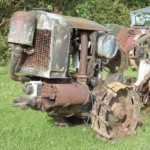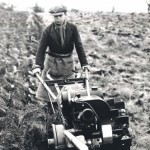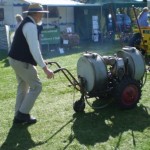Home › Forums › General › Help and information › Douglas interplant hoe and gapper
- This topic has 6 replies, 4 voices, and was last updated 1 year, 7 months ago by
 will-haggle.
will-haggle.
-
AuthorPosts
-
November 13, 2023 at 9:55 pm #41402
booshe-bond
ParticipantMy Dad and I have renovated this wonderful piece of machinery after it was gifted to us in a terrible state. Despite trying to research it we have drawn a blank.
Can anyone please tell us anything about either the company who made it, when the hoes were manufactured and/or what exactly it was used for and who may have used it?
Alternatively, a link to where I might find the information myself. I’m happy to research if I know where to start.
Thank you, Sally
November 14, 2023 at 8:22 am #41404 charlieKeymaster
charlieKeymasterSally, you appear to have a Douglas Gapper, for other examples please see https://vhgmc.co.uk/photo-galleries/douglas-auto-gapper/
They were used to take out unwanted plants (thinning) in a row eg sugarbeet, to create gaps and correct spacing.November 14, 2023 at 3:16 pm #41405 trusty220Keymaster
trusty220KeymasterJust to add a little more to Charlie’s post you will need to understand that most seed drills meter out a measured quantity of seed for a given distance travelled; they make a groove in the soil, pour a measured amount of seed into the bottom of the groove then cover it over in one continuous operation. This results in a continuous row of seedlings once they’ve germinated and so a gapper was used to take out unwanted seedlings and create gaps in the rows so that the plants could expand and grow into the gaps. If it wasn’t done you would end up with too many plants fighting each other for the available nutrients in the soil and this would consequently produce a poor crop of dwarf plants rather than a good crop of fewer but healthier and larger plants, which is what most people would aim at.
You could always do the same job by hand which would be costly and tie up a farm labourer for days. It was easier to pay a youngster to do it and buy a machine he could use so he didn’t get it wrong.
I hope that goes some way to explaining why these were used; these days seed is more expensive and modern seed drills can give a more precise delivery, so gappers have passed into history.
I hope that helps your understanding of a unique type of machine. Enjoy it, and I would recommend planting some sugar beet seed in the spring so you can try it out!
November 14, 2023 at 9:52 pm #41406booshe-bond
ParticipantHi Charlie
Thank you for taking the time to provide and explanation and link to other photos, it has helped firm up the image in our heads. Despite my Dad farming his whole life, he had never come across anything like this before. I’m kinda wishing we’d had one when I was growing up…it would have saved a lot of the hand hoeing that I did over the years (including copious fields of sugar beet) 😂.-
This reply was modified 1 year, 8 months ago by
booshe-bond.
November 14, 2023 at 9:56 pm #41407booshe-bond
ParticipantThank you for taking the time to give me the extra information…as a farmer’s daughter I was the youngster “employed” to do these jobs 😂. This definitely would have made hoeing the sugar beet easier than hand hoeing. I can just imagine my Dad’s face if I turn up saying I want to plant some sugar beet in the veg plot to try it out 😊.
November 15, 2023 at 8:46 am #41412December 3, 2023 at 9:20 am #41519 will-haggleParticipant
will-haggleParticipantDouglas made agricultural equipment, shoe making tools, motorcycles and Italian Vespa scooters all in Kingswood Near Bristol.
-
This reply was modified 1 year, 8 months ago by
-
AuthorPosts
- You must be logged in to reply to this topic.

